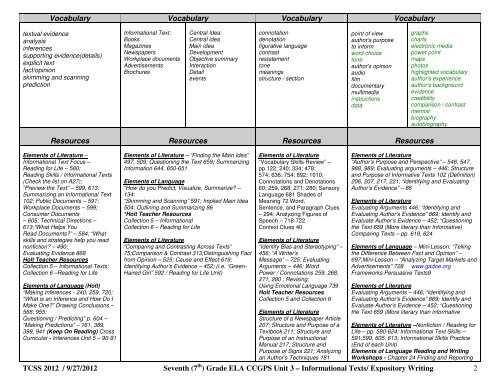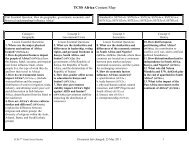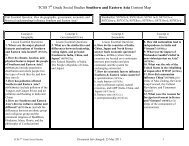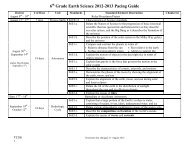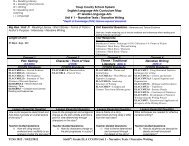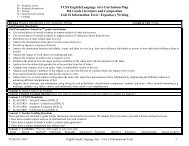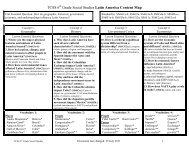TCSS 2012 / 9/27/2012 Seventh (7 ) Grade ELA CCGPS Unit 3 ...
TCSS 2012 / 9/27/2012 Seventh (7 ) Grade ELA CCGPS Unit 3 ...
TCSS 2012 / 9/27/2012 Seventh (7 ) Grade ELA CCGPS Unit 3 ...
Create successful ePaper yourself
Turn your PDF publications into a flip-book with our unique Google optimized e-Paper software.
Vocabulary Vocabulary Vocabulary Vocabulary<br />
textual evidence<br />
analysis<br />
inferences<br />
supporting evidence(details)<br />
explicit text<br />
fact/opinion<br />
skimming and scanning<br />
prediction<br />
Resources<br />
Elements of Literature –<br />
Informational Text Focus –<br />
Reading for Life – 580;<br />
Reading Skills / Informational Texts<br />
(Check the list on A<strong>27</strong>);<br />
“Preview the Text” – 599, 613;<br />
Summarizing an Informational Text<br />
102; Public Documents – 591;<br />
Workplace Documents – 599;<br />
Consumer Documents<br />
– 605; Technical Directions –<br />
613;”What Helps You<br />
Read Documents?” – 584; “What<br />
skills and strategies help you read<br />
nonfiction? – 490;<br />
Evaluating Evidence 868<br />
Holt Teacher Resources<br />
Collection 5 – Informational Texts;<br />
Collection 6 –Reading for Life<br />
Elements of Language (Holt)<br />
“Making Inferences - 240, 259, 720;<br />
“What is an Inference and How Do I<br />
Make One?” Drawing Conclusions –<br />
568; 955;<br />
Questioning / Predicting” p. 604 –<br />
“Making Predictions” – 161, 389,<br />
399, 941 (Keep On Reading) Cross<br />
Curricular - Inferences <strong>Unit</strong> 5 – 90-91<br />
Informational Text:<br />
Books<br />
Magazines<br />
Newspapers<br />
Workplace documents<br />
Advertisements<br />
Brochures<br />
Resources<br />
Central Idea:<br />
Central idea<br />
Main idea<br />
Development<br />
Objective summary<br />
Interaction<br />
Detail<br />
events<br />
Elements of Literature – “Finding the Main Idea”<br />
497, 509; Questioning the Text 659; Summarizing<br />
Information 644, 650-651<br />
Elements of Language<br />
“How do you Predict, Visualize, Summarize? –<br />
134;<br />
“Skimming and Scanning” 591; Implied Main Idea<br />
504; Outlining and Summarizing 86<br />
*Holt Teacher Resources<br />
Collection 5 – Informational<br />
Collection 6 – Reading for Life<br />
Elements of Literature<br />
“Comparing and Contrasting Across Texts”<br />
75;Comparison & Contrast 313;Distinguishing Fact<br />
from Opinion – 525; Cause and Effect-619;<br />
Identifying Author’s Evidence – 452; (i.e. “Green-<br />
Haired Girl” 592 / Reading for Life <strong>Unit</strong>)<br />
connotation<br />
denotation<br />
figurative language<br />
contrast<br />
restatement<br />
tone<br />
meanings<br />
structure / section<br />
Resources<br />
Elements of Literature<br />
“Vocabulary Skills Review” –<br />
pp.122; 240; 334; 478;<br />
574; 636; 754; 892; 1010;<br />
Connotations and Denotations<br />
60; 259, 268, <strong>27</strong>1; 280; Sensory<br />
Language 681 Shades of<br />
Meaning 72 Word,<br />
Sentence, and Paragraph Clues<br />
– 294; Analyzing Figures of<br />
Speech – 718-722<br />
Context Clues 40<br />
Elements of Literature<br />
“Identify Bias and Stereotyping” –<br />
456; “A Writer’s<br />
Message” – 725; Evaluating<br />
Arguments – 446; Word<br />
Power / Connotations 259, 268,<br />
<strong>27</strong>1, 280 ; Revising:<br />
Using Emotional Language 739<br />
Holt Teacher Resources<br />
Collection 5 and Collection 6<br />
Elements of Literature<br />
Structure of a Newspaper Article<br />
207; Structure and Purpose of a<br />
Textbook 211; Structure and<br />
Purpose of an Instructional<br />
Manual 217; Structure and<br />
Purpose of Signs 221; Analyzing<br />
an Author’s Techniques 181<br />
point of view<br />
author’s purpose<br />
to inform<br />
word choice<br />
tone<br />
author’s opinion<br />
audio<br />
film<br />
documentary<br />
multimedia<br />
instructions<br />
data<br />
graphs<br />
charts<br />
electronic media<br />
power point<br />
maps<br />
photos<br />
highlighted vocabulary<br />
author’s experience<br />
author’s background<br />
evidence<br />
credibility<br />
comparison / contrast<br />
memoir<br />
biography<br />
autobiography<br />
Resources<br />
Elements of Literature<br />
“Author’s Purpose and Perspective” – 546, 547,<br />
988, 989; Evaluating arguments – 446; Structure<br />
and Purpose of Informative Texts 102 (Definition)<br />
206, 207, 217, 221; “Identifying and Evaluating<br />
Author’s Evidence” – 86<br />
Elements of Literature<br />
Evaluating Arguments 446; “Identifying and<br />
Evaluating Author’s Evidence” 869; Identify and<br />
Evaluate Author’s Evidence – 452; “Questioning<br />
the Text 659 (More literary than Informative)<br />
Comparing Texts – pp. 619, 624<br />
Elements of Language – Mini-Lesson: “Telling<br />
the Difference Between Fact and Opinion” –<br />
697;Mini-Lesson – “Analyzing Target Markets and<br />
Advertisements” 728 www.gadoe.org<br />
Frameworks Persuasive Texts9<br />
Elements of Literature<br />
Evaluating Arguments – 446; “Identifying and<br />
Evaluating Author’s Evidence” 869; Identify and<br />
Evaluate Author’s Evidence – 452; “Questioning<br />
the Text 659 (More literary than informative<br />
Elements of Literature –Nonfiction / Reading for<br />
Life – pp. 580-624; Informational Text Skills –<br />
591,599, 605, 613; Informational Skills Practice<br />
(End of each <strong>Unit</strong>)<br />
Elements of Language Reading and Writing<br />
Workshops - Chapter 24 Finding and Reporting<br />
<strong>TCSS</strong> <strong>2012</strong> / 9/<strong>27</strong>/<strong>2012</strong> <strong>Seventh</strong> (7 th ) <strong>Grade</strong> <strong>ELA</strong> <strong>CCGPS</strong> <strong>Unit</strong> 3 – Informational Texts/ Expository Writing 2


